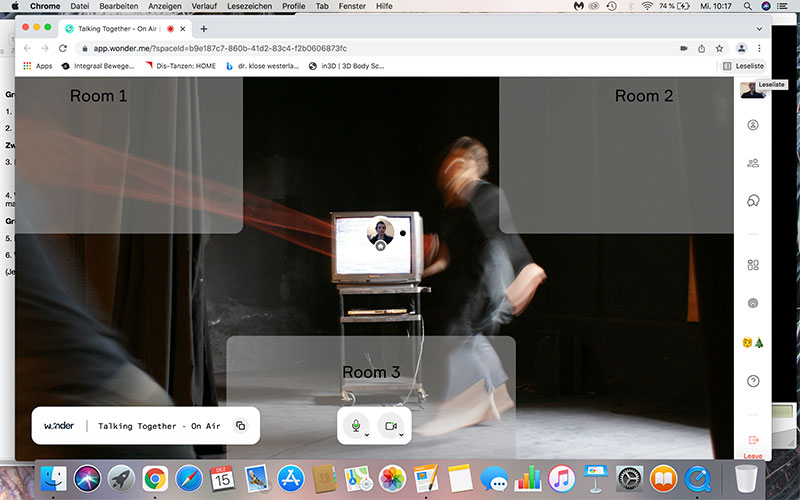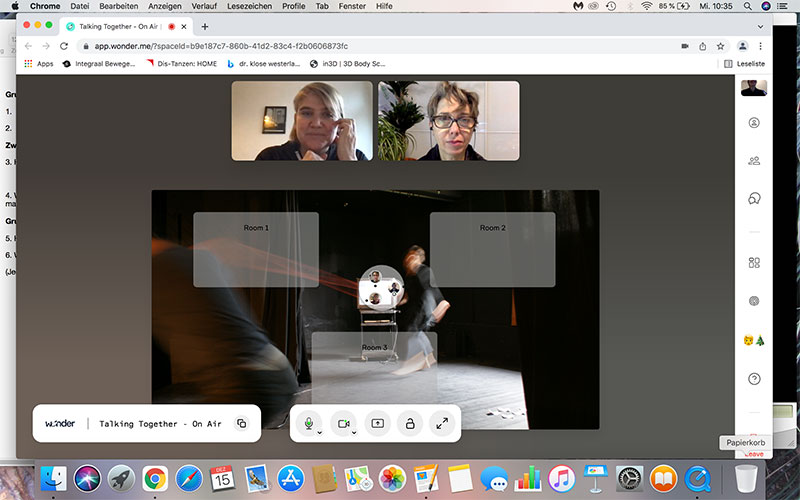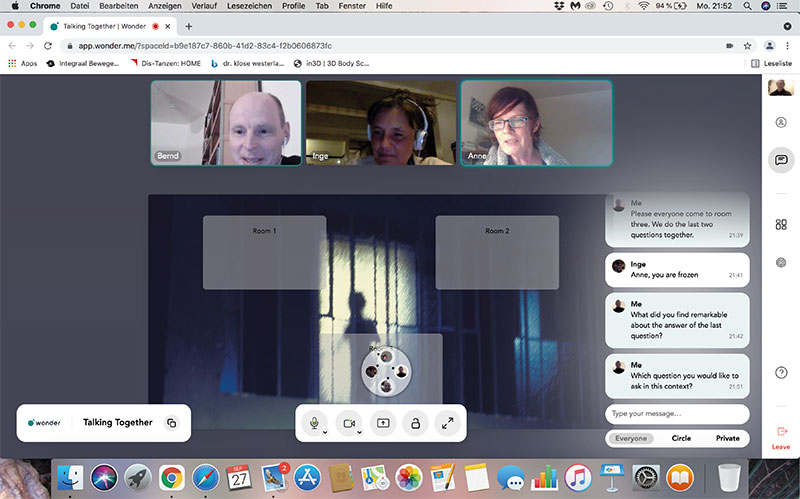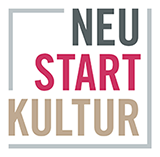Talking Together - On Air
A Textual Reflection by S. Augart

Research _Physical Space / Digital Space
Phase I
Talking Together - On Air is based on an existing artistic mediation format in which the audience engages in exchange in a physical space. Research was conducted to see whether the format would also work in a digital form, and what new aspects this could bring to dance mediation (in times before and after Corona).
In my previous work practice, I paid little attention to the aspect of purely consuming art and performance.
On different levels and in different media, I seek to establish a relationship between artwork and audience. Until recently, the physical space, where body and "spirit" are present at the same time, had always been the fixed and reliable component. Since Corona, this physical space has become a risk with unexpected consequences.
My work revolves around a fundamental question I have, namely, how it’s possible to see things in a different light, to expand our own experience and to come into exchange with others.
Corona wasn’t the only serious change of circumstances: I became a mother. Working in a "home office" with a toddler who does not understand the concept of „work" was and is a challenge.
The first step in my investigation was to see what technical options were available for digital exchange formats. In doing so, I came across a variety of applications and (video conferencing) tools, all of which have advantages and disadvantages on a wide variety of levels.
These differ significantly in so far as
- How many people can participate,
- In their functions: uploading your own pictures or designing virtual rooms, sharing video links, speakers and breakout rooms, etc.,
- Whether they are free or require a monthly fee, and
- Whether they have an avatar function and allow 3D models.
I opted for the free versions, and for the formats that in my experience and knowledge are more accessible to participants. It had to be taken into account that not everyone can quickly and easily find their way around a new tool, and not every computer system has the appropriate functionality or network capacity.
Another aspect was important to me, namely that the tools are GDPR compliant (General Data Protection Regulation since 2018), and that the General Data Protection Regulation of the EU 2016/679 is adhered to.
Due to the large number of providers and their continuous adaptation of the tools, it was and is a challenge not to give up the "learning by doing" mode.
Initial test runs showed that the Talking Together dialog format is well suited for a transformation into a digital mediation format.
However, one challenge remains: how do we deal with the longing for "real" shared experience and exchange versus the digital biological disembodied world? From conversations with a wide variety of participants and players in the dance field, as well as with young people, a great deal of skepticism remains about mediation formats that take place in digital space.
Talking Together - On Air - Extended Version
Phase II

The second phase of the project Talking Together - On Air - Extended Version could be further developed thanks to a follow-up grant from DIS-TANZ-SOLO. Specifically, two new test runs could take place, as well as smaller preliminary tests. Pivotal for the choice of the tool wonder.me
was the accessibility for the participants as well as the extended possibilities (e.g., broadcast). The attempt to dive into virtual reality, in 3D and with avatars (like Mozilla Hub), was unfortunately not successful. As mentioned in my first phase, it is still too complex for some participants to use this technology or tool. Dealing with the technology or the function of the tools takes up too much time and the audience discussion or talking to each other would take a back seat.
The result of this process is that there is a kind of modular system (an introduction featuring technical instructions, questionnaire, conversation settings) as well as a basic visual structure that can likely be realised in different theatres and embedded in their websites. In order to concretise this embedding, I will take first steps with, among others, the theatre Sophiensaele in Berlin in March 2022.
The archiving of the process will take place continuously, with the collected material being made accessible step by step on the Fragmenta website.
Participants gave this reaction to the test runs:
"I experienced the conversation exercises of Sonja as very playful. It allowed us to share and build on each other's experiences and thoughts, creating a mutual landscape of information." [sic] Annette van Zwoll
"As someone who had the luck to participate both in the Digital and the 'Original' Talking Together-Aftertalks, I can tell that the Digital Version made me be more focussed, on what I wanted to say. Because there was no distraction caused by a near-by 'real' person. But on the other hand, this is also the negative part of the Digital version: I missed Inge's and Sonja's charming presence."[sic] Bernd Neunzling
"Talking Together was a successful "try-out" online because the basic principle is so powerful it works "live" and it work "online". The opportunity to reflect on art that we experience and not just consume and walk away - gave me a rush of new perspectives from my fellow audience members. By staying with the aftermath of a dance performance, I discovered new meanings and associations. It gave me the chance to connect dots, and as a result appreciate more the efforts and ideas of the artists on stage. Sonja Augart is onto something with Talking Together! I would like to invite her to use this same tool with an audience from my show THE bEAR.“ [sic]
Dyane Neiman
The reaction of the test runs’ participants show what digital audience discussion has to offer. A playful exchange that links and deepens experiences and knowledge. Talking to each other or listening to each other's perspectives and experiences are tools that we need more than ever in today's society. At the same time, this format empowers people to value their own perceptions and to add them to a discussion.
In the future, when digitalisation is pushed forward in institutions and theatres, there should also be a digital space that is made available for direct interactive exchange by the audience (e.g., on the website or in the theatre itself).
With my research and results, I can offer a format or method that enables participatory, mediation work based on democratic principles in a sustainable way.




On the blog of the Dachverband Tanz Deutschland you can find more information:
Link: Exisdance Der Blog des Dachverband Tanz Deutschland

